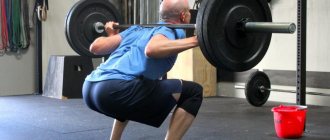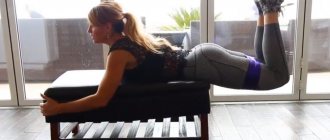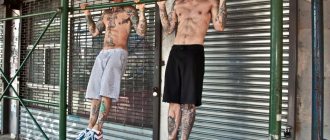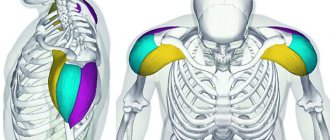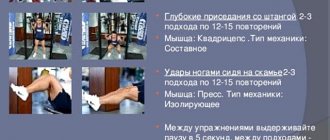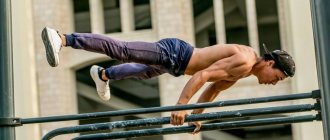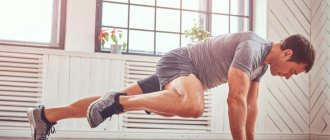Training on the horizontal bar and uneven bars is popular among both amateurs and advanced athletes, because they can be done both in the gym, at home, and in the fresh air: at the stadium or even just in the yard.
With these exercises you can work out all the major muscle groups located in the upper body. Types of exercises on the horizontal bar and parallel bars are pull-ups and push-ups. The horizontal bar is used primarily for pull-ups, and the parallel bars are intended for push-ups. During pull-ups, the latissimus dorsi muscles, biceps, and rear deltoids are loaded. When doing push-ups - triceps, pectoral muscles, anterior deltoids. A set of exercises on the horizontal bar and parallel bars includes various variations of push-ups and pull-ups, performed with different grips and hand positions.
Exercises on the horizontal bar and parallel bars perfectly stretch the muscles, while achieving this by working out on exercise machines can sometimes be problematic. And, as you know, muscles grow when they are maximally stretched under the influence of weights. In this case, the weight of your own body plays the role of burden.
There is a training program on the horizontal bar and parallel bars for both beginners and more experienced athletes, the goal of which is to gain muscle mass.
Before each session, be sure to do a 10-minute warm-up to warm up your muscles. Warm-up may include:
- Jogging;
- Jumping rope;
- Boxing movements or energetic swings of the arms, warming up the fingers.
All exercises should be done smoothly, observing the technique of their implementation, while avoiding inertia and not turning off muscle control for a second.
Proper nutrition
An athlete’s diet should consist of the right amount of protein, fats and carbohydrates. If you are ready to gain weight, then you should consume 30-35% protein, 50-60% carbohydrates and 10-20% fat. Please note that the number of kilocalories consumed should be 10% higher than what your body usually requires. After all, weight training on the horizontal bar and parallel bars requires a lot of energy.
The easiest way to calculate the required calorie content is to multiply your body weight by 30. For example, having a weight of 80 kg, multiply 80 by 30 and get 2400 kilocalories. This is an approximate figure for a person who does not engage in heavy physical labor.
So, as we already understood, the number of kilocalories contained in food will vary depending on your goals. If you do weight training on the horizontal bar and parallel bars, increase the calorie content by 10%; if you want to lose weight, reduce it by 10%. When calculating, everything is simple, it becomes more difficult when you need to force yourself to follow the right diet. But here everything depends only on the strength of your motivation. Don't neglect your nutrition, besides training for mass on the horizontal bar and uneven bars, nutrition makes up a significant percentage of your future success or failure.
We recommend that you choose animal protein, as it contains all the amino acids the body needs, while plant protein, depending on the type of product, contains only some types of amino acids. Thus, to consume complete protein, you will need to combine several types of plant foods. The best dietary product for an athlete is, of course, chicken breast; it contains a large amount of animal protein with a low fat content.
Carbohydrates must be complex, that is, during digestion they should not provoke a sharp release of insulin into the blood. Such carbohydrates are found in cereals; we recommend taking a closer look at buckwheat, brown/wild rice or basmati rice, as well as pearl barley.
Carefully monitor the amount of fat you consume. Forget about mayonnaise, ice cream, and other products containing large amounts of animal fat. Your choice is vegetable fats, they are tasty and healthy. For example, instead of mayonnaise, you can season salads with olive oil, which will not spoil them in any way. Well, your training program will take care of the rest. The horizontal bar, parallel bars and dumbbells should become your best friends.
Types of push-ups
There are two types of dips:
- Dips with emphasis on triceps. With such push-ups, the hands are positioned as narrowly as possible. The position on the uneven bars with straight arms will be our highest point of amplitude. The exercise is performed by bending your elbows with your body tilted forward. At the moment when your elbows are bent at an angle of 90 degrees, you should stop - this is our lowest point of amplitude. While performing the exercise, press your hands to your body. Using this technique, you will provide load to all three heads of the triceps - long, lateral and medial.
- Push-ups on parallel bars with an emphasis on the chest. Hands should be positioned with a wide grip. Moreover, when performing the exercise, the arms are not pressed against the body, but, on the contrary, are spread to the sides. The rest of the exercise is done using the same technology. This technique will give a good load to your chest, namely its lower part.
What muscles work
Dips provide a workout for all the muscles of the body, primarily the pectoral and triceps. The emphasis will depend on the placement of the hands and the tilt of the body.
The triceps muscle makes up the lion's share of the arm volume. When doing push-ups, it is the internal head that mainly works, since it is responsible for the extension of both the shoulder and elbow joints. The outer and middle heads are less involved.
The pectoral muscles also act as extensors, returning the arms to their original position after moving the elbows behind the back, and activating the shoulder joint.
Unlike the triceps, all components of the pectoral muscles work under full load.
A number of muscles perform stabilizing and auxiliary functions: the serratus, lower trapezius, rectus dorsi, and even the gluteal muscles.
If we are talking about a parallel bars training program for beginners, then in the first stages they will be developed on a par with the main groups.
Training principles
- Do not exercise for more than 1 hour, otherwise you risk the consequences of overtraining.
- The optimal number of classes per week is from 2 to 4.
- Use a specific weight training program. The horizontal bar and parallel bars require a conscious approach, otherwise the results will disappoint you.
- To not only get stronger, but also gain muscle mass, you need to use additional weight in your exercises. It should be heavy enough that you cannot do more than 10-12 repetitions of one exercise at a time. As a rule, at home athletes use backpacks filled with something metal. Be sure to record the weight of the backpack so that in the future, changing its contents will increase the weight, not decrease it.
- You can use a horizontal bar, parallel bars and dumbbells in your training. You can customize the training program depending on your physical capabilities.
How to achieve maximum exercise effectiveness in a month
The following rules will allow you to achieve maximum effectiveness in performing exercises:
- be sure to do a warm-up - it will allow you to warm up your muscles;
- When doing pull-ups, pay attention to muscle strength and avoid inert movements;
- do not jerk while raising and lowering your body, all movements should be smooth;
- don't swing;
- concentrate on working your biceps;
- control your breathing - inhale when you go down, exhale when you go up.
There are many methods with which you can pump up your biceps in a month, but the horizontal bar is still the most affordable of them.
And although you can get results faster with free weights, you can also increase your biceps with pull-ups. True, you will have to be patient. And do not forget to follow the general recommendations (they are presented below).
A short video with motivation and practical tips.
Remember to stretch your biceps on your own or with a partner.
Regularity of training per week
The optimal number of classes per week is 2-3 times.
It is important to alternate them with rest, which is extremely important for muscle fiber growth. Actually, this process begins during recovery, and not tension, as many novice bodybuilders think.
If you feel muscle pain, it is better to take a break and skip the workout. There is no point in exercising in this state: the effect will be much lower, and the risk of deterioration in well-being will be higher.
Number of sets
Assess your strength adequately: do not try to do maximum repetitions. To train the biceps, it is enough to perform 3-4 sets of 8-12 repetitions, but if you cannot initially take this amount, at the initial stage, do as much as you can, then gradually increase.
Rest between sets
The recommended rest time between sets is 2 minutes.
Increasing load
Gradually add load, this will “shake up” the muscles and stimulate them to grow.
Smoothly increase the number of sets and repetitions in each approach. Or you can use an alternative method: add weight to your own body using a backpack or weighted belt.
In this case, fewer repetitions can be done, but their number in each set should still not be less than 6.
Technique
Undoubtedly, the correct technique for performing the exercise is important. Only with its help will you get the maximum effect and avoid injury. Distribute all exercises on different days of the week, this way you will prevent overexertion of your biceps.
What is the ideal grip for biceps training? Supinated, performed from below. As for width, it is better to give preference to a narrow grip, because... in this case, the muscles of the arms, chest and shoulders work more.
In addition, we recommend that you familiarize yourself with the training for the month with Alexey Schroeder.
Nutrition and supplements
A special diet helps build muscle mass, and supplements speed up this process. The main element that affects muscle growth is protein. Make sure you have enough of it in your diet, and don’t forget about the other components of food - the diet should be balanced.
| Vitamin-mineral complex | During intense physical activity, vitamins and minerals are consumed by the body faster. They are also responsible for protein synthesis and are the engine of metabolic processes. |
| Glucosamine and chondroitin | Fills joints, ligaments and tendons with essential substances for prevention or recovery after injury |
| BCAAs | Allows muscle fibers to recover faster and provides building material for the growth of lean muscle mass. |
| Whey Protein | The most popular protein supplement for muscle growth. The main source of this protein is whey. |
Tips for doing dips
- When training on parallel bars for weights, do not hold your breath during exercises. During physical activity, the body requires oxygen more than ever. For the best supply of oxygen to the muscles, use the following technique: when lowering the body, inhale, when lifting, exhale.
- Perform the exercises smoothly, without jerking. This way you will work out each muscle better, which will ultimately lead you to even more outstanding results.
- If you encounter pain during peak lifting or lowering of the body, reduce the amplitude. That is, perform exercises with smaller angles. This will create a low peak load on your muscles, but will protect your joints and ligaments.
- If you don't have enough strength to do dips, do regular push-ups at first. After some time, when your muscles get stronger, you will be able to switch to parallel bars without any problems.
Working out the press on uneven bars
In pursuit of the desired six-pack, people become fixated on classic crunches and well-promoted benches. Meanwhile, it is the parallel bars that can provide the fastest and most aesthetic pumping of the lumbar region, but the role of this projectile has been undeservedly forgotten.
In addition to the fact that the abdominal and oblique muscles work as auxiliary muscles in any exercise on the uneven bars, there are ways to focus specifically on the abs. Here is one of them:
We perform an approach to the uneven bars in the starting position, with weights on our feet.
Raise your knees towards your body, keeping it straight. The first repetition is lifting straight, the second is bending to the left, the third is to the right.
And such a cycle is for about 15-30 repetitions, the number of approaches until failure. Recovery break for three days.
After several months of training, when lifting with bent knees becomes too easy, repeat the same thing with straight legs.
Why is this more effective than traditional methods?
The abdominal and oblique muscles work synchronously with the support of the back in everyday life, and the load on them is distributed evenly.
As with practicing this method. Collaborative work will give a more tangible effect than local work.
Exercises on the horizontal bar for gaining weight
Your no less important companion in the struggle for an ideal body is a tool beloved by many - the horizontal bar. It can be found in almost any yard, and if it is not in yours, then it is definitely in the next one. Push-ups on the horizontal bar are considered basic exercises, as they involve more than one joint. Which muscles are used more than others depends on the type of grip used.
Is it possible to pump up on the horizontal bar?
To achieve muscle growth, you need to work hard. And yes, it is quite possible to achieve such a result on the horizontal bar if the training scheme is appropriate. The only thing that is important to immediately understand is which muscle groups the horizontal bar will help pump up.
When you pull yourself up, your biceps, shoulders, back muscles, and abs work. Grip strength, that is, the muscles of the forearm, is also well trained. Your legs are resting as if they were at a resort. You can even imitate walking while hanging - your legs will still not swing. But the abs tense well at such moments, especially the lower part.
From the back side, the latissimus, trapezius, teres and rhomboid muscles swing.
In addition, pull-ups, as well as simply hanging on a horizontal bar, are considered very beneficial for health. This position allows you to naturally straighten your spine. While you are hanging, gravity is pulling your body down. The entire back is stretched, the vertebrae are in the correct position.
By working out on the horizontal bar, you can both pump up the muscles of your back, abs and arms, and improve your own spine.
Types of grip when pulling up on a horizontal bar
- Straight grip. This is the classic grip that is taught in school physical education classes. Hands are fixed on the horizontal bar with palms facing away from you. When performing pull-ups, you use muscle groups: back, biceps, triceps, forearms and deltoids.
- Reverse grip. This grip is easier to perform than the previous one. To perform it correctly, you need to fix your hands on the crossbar, with your palms facing you. This way you can work your biceps and back muscles.
- Parallel grip. With this type of grip, one hand is placed on the horizontal bar with the palm facing away from you, the other with the palm towards you. This type of grip primarily works the lower latissimus dorsi muscles. And if you do full pull-ups, touching your chin to the bar, your biceps will also actively participate in the pull-ups.
- Wide grip. By doing pull-ups with a straight, wide grip, you are doing a great job of working the trapezius, upper lats, and teres muscles. When performing pull-ups behind your head, the lower part of the latissimus muscles is activated. This is an excellent exercise for gaining muscle mass on the horizontal bar. Use the following technique: grab the horizontal bar wider than your shoulders, your thumb should be on the side of your palm, do not wrap it around the horizontal bar. During the exercise, make sure that there is 90 degrees between the forearm and the horizontal bar. As you lift your body, touch the bar with your chest.
- Narrow grip. With a straight close grip, you work the lower lats, brachialis, and serratus anterior muscles. While a reverse grip will allow you to engage your biceps. Technique for performing the exercise: grab the horizontal bar; palms should almost touch each other; hang from the bar and arch your back. Cross your legs to prevent your body from swaying. Bending your arms, try to touch the horizontal bar with your chin. Moving in the opposite direction, do not jerk, continue to extend your arms to 180 degrees at the elbows.
- Medium grip. This type of grip is used like the previous one, except that your hands are placed on the horizontal bar at shoulder width, and you should touch the bar with your upper chest. Using a straight medium grip, you'll work your shoulders, triceps, biceps, forearm flexors, and back muscles. With a reverse grip, you engage your biceps and latissimus dorsi.
Execution technique
Acceptance of the starting position
The exercise is performed in support on the uneven bars. To accept it, you must:
- take the parallel bars with a medium grip, palms facing each other;
- by lightly jumping with your legs, take a standing position;
- move your shoulders away from your ears, relax your trapezius;
- place the body vertically so that it stands stably in the bars
The starting position can also be taken from a stand if the projectile is high and it is not possible to jump into a standing position without overloading the shoulder joints. Push-ups in the gym are performed on standard racks that have foot rests. If the exercise is done with a weight attached to the belt, it is advisable not to take the starting position on the uneven bars with a jump, so as not to injure your shoulders.
Movement
Lowering the body occurs with inhalation. You need to inhale slowly and lower your body under control in one movement, elbows bent together. Exhalation occurs with effort. Having lowered your body until your forearm is parallel to the floor, you should exhale sharply and, as it were, “squeeze” your body up. Next, the entire planned series of push-ups is performed, and the athlete places his feet on the bars and carefully returns to the starting position. During movement, you need to focus on the work of the triceps.
Attention
A technical mistake is to slouch your shoulders forward and perform the exercise with a round back. This is dangerous because when you slouch, the shoulder joints are overloaded, and the person risks injuring the ligaments.
There is no need to “insert” your elbows as on a competitive bench press, this overloads the elbow joints and when performing other high-repetition work on the elbows (presses in machines, with a barbell and with dumbbells), it can lead to injury;
“Throwing” the body down is also a mistake and can lead to injury. In addition, the lack of control during the lowering phase does not allow the athlete to effectively work out the muscles.
Raising the elbows to the sides in the triceps version of the press is not allowed, since the athlete thus shifts the load on the pectoral muscles.
Recommendations
- Preliminary joint warm-up and light stretching of the triceps, anterior shoulder and biceps are mandatory;
- Each athlete must find an adequate depth of descent for themselves, comfortable for the shoulder joint, and convenient anthropometrically. Push-ups that are too deep can cause hyperextension of the ligaments.
- You can consciously press your elbows to your sides, this will remove excess stress from the muscles of the shoulders and chest, and shift the work to the triceps.
- It is important to stop at the bottom point, contract the muscles, and avoid inertia in the movement in order to get more targeted work;
- Straightening your legs will help avoid swaying and excessive leaning forward. With your knees bent, it is easier to perform the “chest” rather than the triceps version of this exercise.
It's DIPS, baby! (for BREASTS)
Training program. Exercises on horizontal bars and parallel bars for weight
Due to the fact that parallel bars and horizontal bars are a complete replacement for the gym, you can create an effective training program that will lead you to excellent results. Athletes who use horizontal bars and parallel bars in their training have more prominent and well-developed latissimus dorsi muscles.
The muscle volume, however, is less than that of athletes training in the gym, but this is due to the “puffiness” of the muscles of bodybuilders. The efficiency and muscle strength of lovers of the horizontal bar and uneven bars are much higher.
To achieve results, you need to exercise 3 times a week. In the first week you practice on the horizontal bar, in the second week on the uneven bars, plus partly on the horizontal bar. Then repeat the first week, and so on. So, our program for weight: horizontal bar, dips.
Relief development
Not all athletes set themselves the goal of increasing muscle mass. For many, endurance and drawing are more important.
The parallel bars training program for relief involves a large number of repetitions with your own weight.
The nature of training in this case will be determined by the specific goal of the athlete.
If you need to dry out in general, reduce the subcutaneous fat layer as much as possible so that the muscle relief becomes clearly visible, then the entire training process will be built on an aerobic principle.
You sweat, you feel an overload of the respiratory system - it means you are doing everything right, the excess weight is gone.
Exercises on parallel bars are very energy-intensive by default, so they are perfect for this purpose.
The main thing is not to cross the fine line, from which, along with getting rid of fat, the body begins to burn muscles.
To avoid this, just follow the following recommendations:
- Let the body rest, all the main processes occur during sleep, as a response to the work done during the waking period;
- Take cortisol blockers, the so-called “stress hormone” that destroys muscles, for example, ascorbic acid is available and safe;
- Do not consume fast carbohydrates (sugar) before training; the body will not begin to use fat as energy while the blood is saturated with glycogen;
- Avoid alcohol, nicotine and junk food.
But sometimes it happens that there are no problems with excess weight, and the athlete is simply dissatisfied with individual muscles and even bundles of muscles.
In this case, isolation training will be useful. All muscle groups listed in the article can be improved to overall body condition in a targeted way.
One cannot ignore the so-called plyometric exercises, on the basis of which the increasingly popular CrossFit culture is based.
Their essence lies in the fast and explosive execution of repetitions, when at the end point of the amplitude the body hangs in the air for a moment.
Dilute your weekly parallel bars training program with plyometrics, and your efficiency will increase significantly, your circulatory system and heart will be strengthened.
1st week
- Monday. Pull-ups with a straight medium grip. 5 sets with maximum reps. Rest between sets as much as your muscles require, but it is advisable that the break is no longer than 3 minutes. Perform the exercise smoothly, without jerking. Snatching will reduce the quality of the pull-up and reduce the effect on your muscles. Abdominal exercise – “Frog”. We hang on the horizontal bar and pull our knees to our chest. The ideal execution is to touch your chest with your knees.
- Wednesday. Reverse close grip pull-ups. 5 sets with maximum reps. Then we take a short break and move on to the next exercise. Inversion raise, 3 sets with maximum reps.
- Friday. Pull-ups with a straight wide grip - 5 sets with a maximum number of repetitions in each. Let us remind you that the ideal exercise is to touch the bar with your chest. Small break. Wide grip pull-ups with the bar behind your head, 5 sets with the maximum number of repetitions in each.
Training program
Day one - we train the chest and triceps:
- Push-ups on parallel bars in the chest style - 3 sets of 15-20 times.
- Push-ups on narrow bars for triceps - 3 sets of 15-20 repetitions.
- Push-ups for front delts - 3 sets of maximum reps.
- Push-ups - 3 sets for the maximum number of times.
Day two - pumping up your back and biceps:
- Wide-grip pull-ups to the chest - 3 sets for a maximum of reps.
- Medium grip pull-ups - 3 sets of 10-15 reps.
- Pull-ups with a narrow reverse grip - 3 sets of 10-12 repetitions.
- Parallel grip pull-ups - 3 sets for the maximum number of reps.
Day three - working on the legs:
- Single leg squats - 3 sets max.
- Jumping lunges - 3 sets of 15-20 reps.
- Gluteal bridge - 3 sets of 20 reps.
- Weighted calf raises - 3 sets for maximum reps.
Contraindications
Active exercises on the horizontal bar are not recommended for people with the following health problems:
- cardiovascular disorders;
- kidney or gallstones;
- diseases of the gastrointestinal tract;
- recovery after surgery.
We also do not recommend performing exercises on the horizontal bar for people with scoliosis.
The reason lies in the uneven load on the muscles when performing exercises, which can lead to disastrous consequences. After all, weight training on the horizontal bar and parallel bars belongs to the category of complex exercises.
What to consider when working out on the 3 in 1 horizontal bar
Each workout should be preceded by a warm-up to warm up the muscles and joints. Jumping rope, jogging, basic exercises such as bending, lunging, rotating joints, etc. are perfect. Move smoothly, not abruptly, keeping your whole body under control. This also applies to exercises on apparatus.
While doing pull-ups, try not to sway. Raising your body upward, bring your shoulder blades together - this way you more strongly engage the latissimus dorsi muscles, which should take on the main load. Pushing out the body should be carried out precisely due to them, and not due to the load on the muscles of the biceps and forearms.
